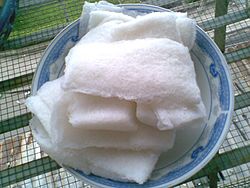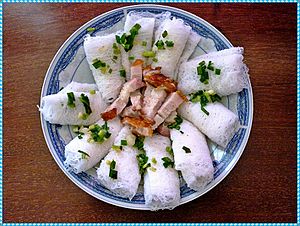Bánh hỏi facts for kids

Bowl of Bánh hỏi
|
|
| Type | Noodle |
|---|---|
| Place of origin | Vietnam |
| Region or state | Bình Định Province |
| Main ingredients | Rice vermicelli, scallions or garlic chives |
Bánh hỏi (Vietnamese: [ɓaɲ hɔːj]) is a special Vietnamese dish. It's made of rice vermicelli noodles that are carefully woven into cool, flat bundles. These bundles are often topped with fresh scallions or garlic chives that have been cooked quickly in oil.
This tasty dish is usually served with a side of meat. The noodles are super thin, like toothpicks! They are firm enough to hold their shape but not sticky, which makes Bánh hỏi a light and perfect meal, especially for breakfast. Some people even call it "question cake" or "question pie."
Contents
Where Did Bánh hỏi Come From?
Bánh hỏi first started in the Bình Định Province in Vietnam. This area is on Vietnam's South Central Coast. In Bình Định, people love Bánh hỏi so much that they eat it for almost any meal. It's often eaten instead of rice or other noodle soups.
How Is Bánh hỏi Made?
Making Bánh hỏi is a bit like an art project! It takes many steps to create these unique noodles.
Preparing the Rice
First, good quality rice is soaked in water all night long. After soaking, it's washed several times until the water is perfectly clear. Then, the rice is ground into a smooth mixture. Sometimes it's ground with water, or sometimes it's ground dry and then mixed with water later to make it light and fluffy.
Cooking the Dough
Next, the rice flour mixture is either steamed and kneaded, or cooked in a pan. If it's cooked in a pan, it's stirred constantly until it starts to thicken. The goal is to make sure no flour sticks to the stirring tool. This step is super important! It helps make Bánh hỏi soft, light, and not sticky, but still firm enough to keep its shape.
Shaping the Noodles
Once the dough is ready, it's time to shape the noodles. Special copper or aluminum tools are used. These tools are like cylinders with many tiny holes, as small as a needle's eye. The cooked dough is pressed through these holes.
Pressing the dough needs a lot of strength because the dough is hard and the holes are tiny. So, people often use a special lever to help. As one person presses the dough, another person "catches" the noodles as they come out. They press the noodles together and cut them into sections about 10 centimeters long. This creates a cool, mesh-like sheet of noodles. These sheets are then laid out flat, not in layers.
Final Steaming
Finally, these noodle sheets are steamed one last time for about five minutes. This makes them perfect and ready to eat!
How to Enjoy Bánh hỏi
Just like other rice vermicelli dishes, Bánh hỏi is usually served cold.
Traditional Servings
In Bình Định, where it comes from, Bánh hỏi is traditionally rolled into bundles. It's always served with chopped garlic chives. These chives are quickly stir-fried with oil, and their amazing smell and taste go perfectly with the noodles. This makes the dish delicious even by itself, without any other herbs.
Different Ways to Eat It
- In central Vietnam, like in Huế, people eat Bánh hỏi with dried prawns and a dipping sauce called nước chấm.
- In southern Vietnam, Bánh hỏi is often enjoyed with different kinds of meats, especially roast pork or duck.
- You can also find Bánh hỏi with crispy spring rolls (called chả giò), or with shrimp paste on a sugar cane stick.
- Grilled pork, chicken, or beef are also popular toppings.
- At a market in Phú Yên Province, you can even find Bánh hỏi served with boiled pig offal, which is a local specialty.
Special Occasions
Because making Bánh hỏi takes a lot of skill, it's considered a very special dish. It's often served at important parties and celebrations, like weddings or family memorial days.
Keeping It Fresh
To keep Bánh hỏi from getting sour, it's important to cover it tightly so it doesn't dry out. Market sellers often put fresh Bánh hỏi in bamboo baskets lined with banana leaves. They usually leave it open to the air to keep it fresh.
For people who want to cook it at home, you can also find dried, packaged Bánh hỏi. It's like dried pasta, and you can cook it yourself instead of buying it fresh from the market.


